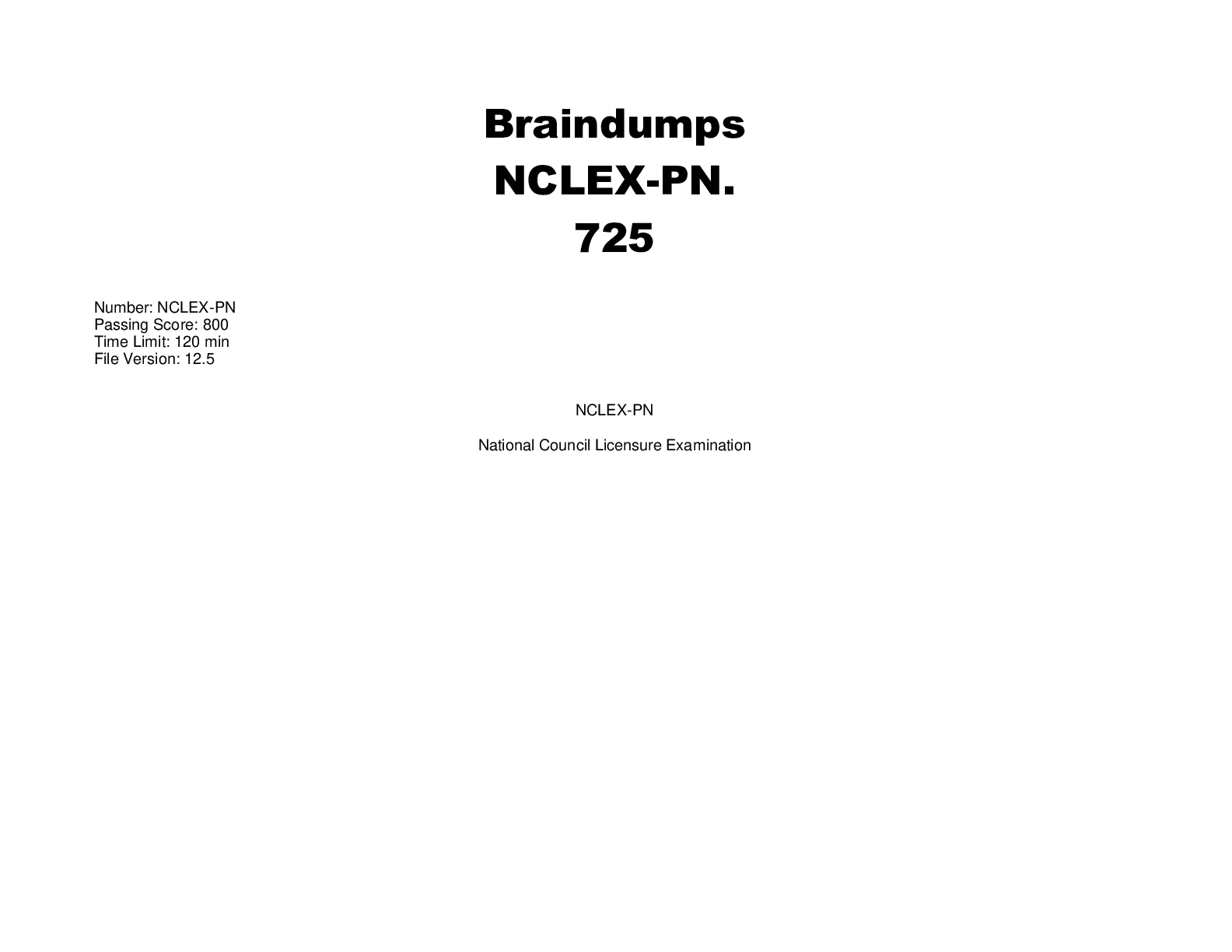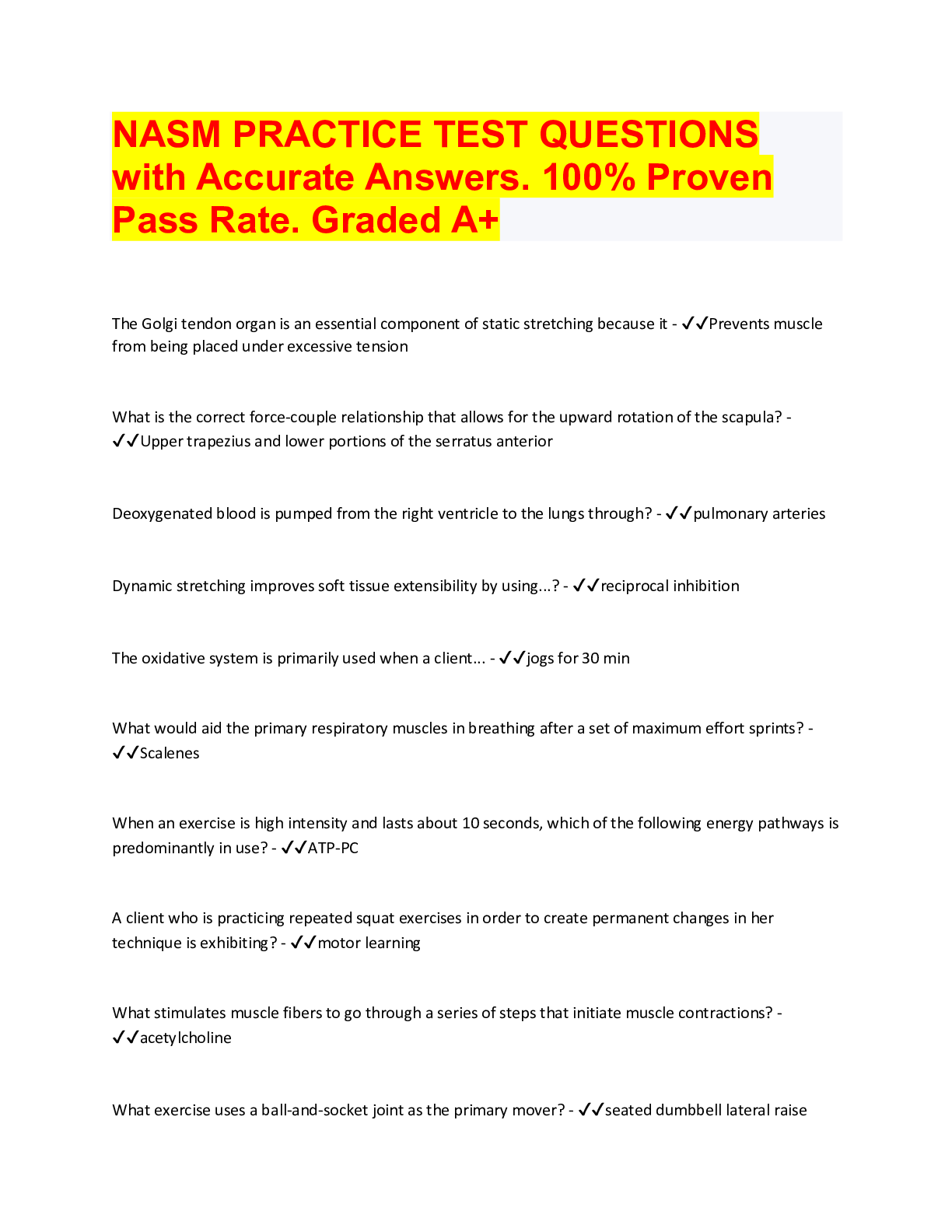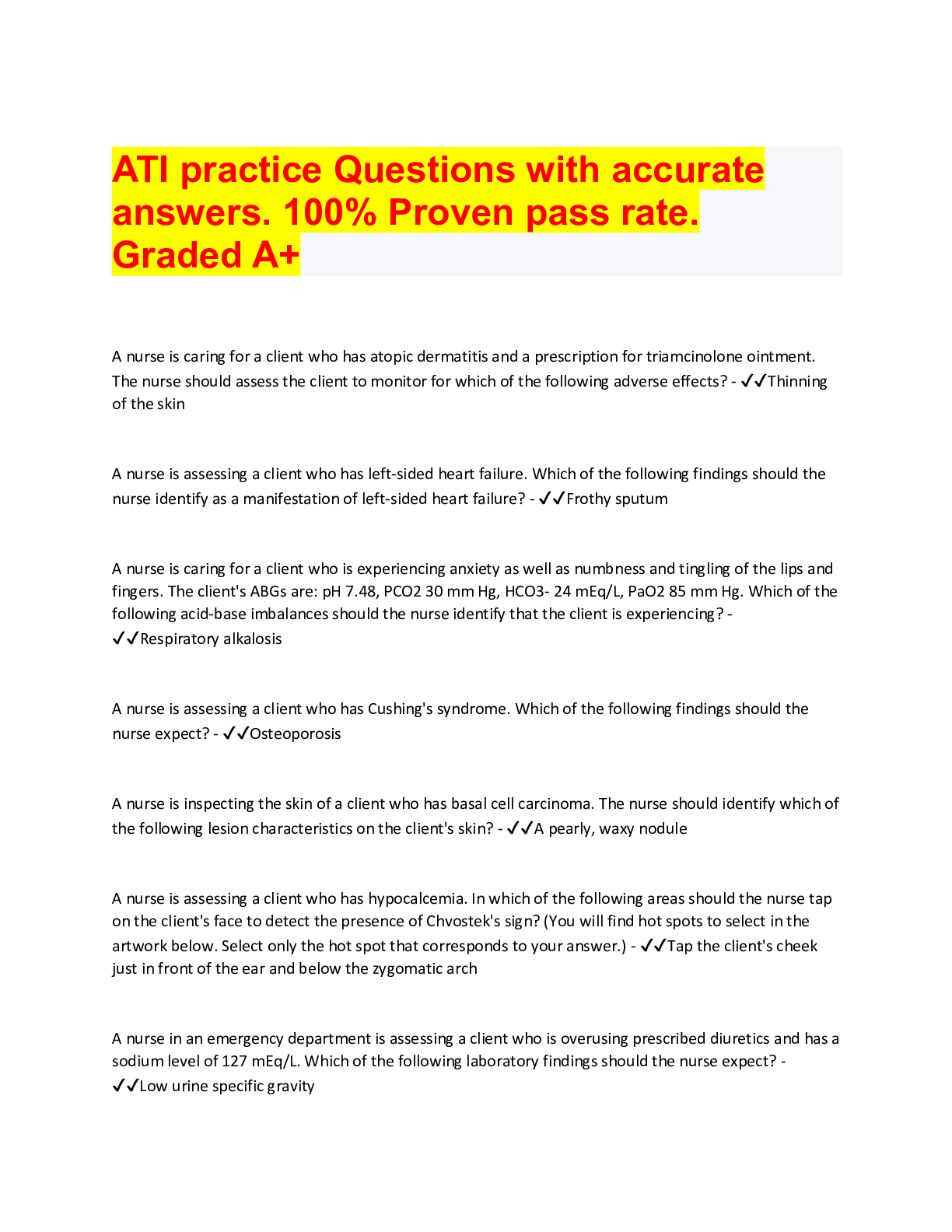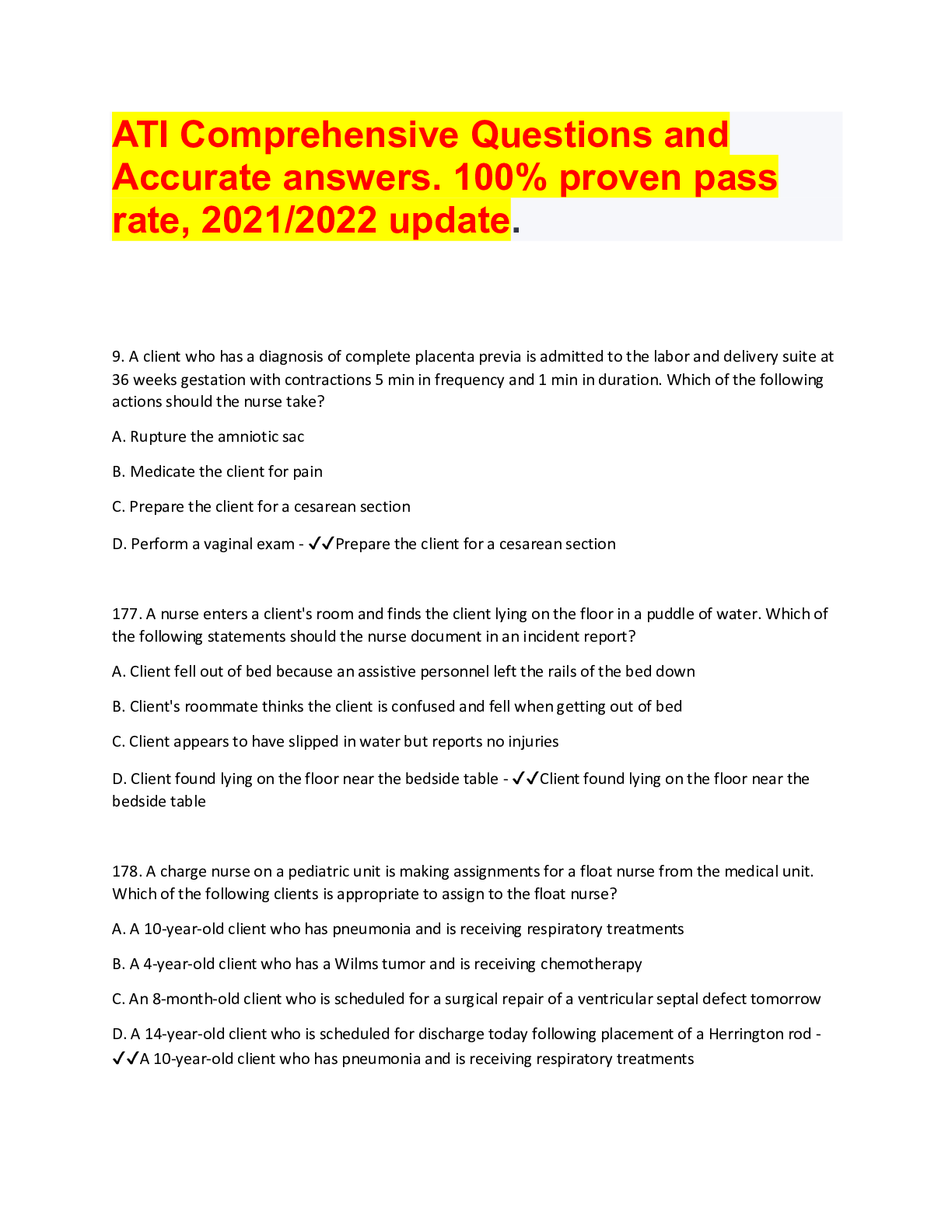*NURSING > QUESTIONS & ANSWERS > NCLEX - CAT Test 2 Review. Questions with accurate answers. 100% approved. (All)
NCLEX - CAT Test 2 Review. Questions with accurate answers. 100% approved.
Document Content and Description Below
The nurse provides care for a child who ingested an unknown substance. The client is unconscious with a respiratory rate of 10 breaths/min, pulse oximeter reading is 88%, and the heart rate is 160 bea... ts/min. The nurse determines which nursing diagnosis is the highest priority for this client? 1.Decreased cardiac output. 2.Ineffective breathing pattern. 3.Ineffective tissue perfusion. 4. Impaired cerebral tissue perfusion. - ☑☑SLOW BREATHING Breathing trumps everything else; it will kill the fastest (T/F) Enteric-coated medications can be given via NG tube - ☑☑FALSE: it has to be crushed Describe proper placement of a patient with below-knee amputation - ☑☑Elevate limb for first 24 hours Put in prone position for first 24 hours Encourage flexion of quad/glut to prevent contractures Proper fitting/usage of crutches - ☑☑2 fingers fit between armpit and crutch top (prevents nerve damage) Arms should not be straight (flexed 20-30) Proper walker usage --How should arms to placed --Movement sequence --Getting into chair sequence - ☑☑Arms should NOT be straight (flexed 20-30 degrees) Lift walker 6 inches in front Walk with bad leg Follow with good leg Grasp arm using bad side Shift weight to good leg Using bad side, lower into chair In general, when going up stairs it is ___ - ☑☑Good leg first when going up Bad leg first when going down Describe proper usage of a cane - ☑☑Hold on good side (opposite bad) When moving on flat ground: 1. Cane + bad leg first 2. Good leg second Do NOT hold with a straight arm (should be flexed) Alendronate administration; what is it used for? - ☑☑1. Take before meals and meds 2. Take with water (6-8 oz) 3. Stay upright afterwards Is a medication used for osteoperosis Changes associated with metabolic acidosis - ☑☑Hyperkalemia Kussmaul respirations (to blow off CO2) Changes associated with acidosis state - ☑☑Hypocalcemia --More acidity = calcium has greater affinity to albumin Leads to HYPER-reflexes Acidosis leads to ___ breathing - ☑☑Rapid (blow off CO2) A patient taking a lot of meds has wheezing. Which common med would you take them off of if they're on it? - ☑☑Beta blockers Cause bronchospasms Alpha-fetoprotein (AFP); what does it mean? - ☑☑Test for neural defects/Down syndrome in fetuses Elevated -> neural tube defects Decreased -> Down syndrome Alcohol withdrawal symptoms - ☑☑1. Hallucinations 2. Tremors 3. Seizures 3. Anxiety 4. Inability to sleep 5. Anorexia Delirium tremens - ☑☑More life-threatening version of alcohol withdrawal, involving: 1. N/V/D 2. Delusions 3. Seizures Which treatments are given for alcohol withdrawal? - ☑☑1. Benzos 2. Anti-seizure eds/precautions If malnourished: 1. Vitamin B12 (thiamine) 2. IV glucose List what each of the 4 heart sounds are, and what they mean? - ☑☑S1 1. "Lub" 2. Contraction of ventricle, relaxation of atria 3. Normal S2 1. "Dub" 2. Contraction of atria, relaxation of ventricle 3. Normal S3 1. Sound AFTER S1/S2 (Lub-Dub-"Noise") 2. Indicates heart failure S4 1. Sound BEFORE S1 2. Indicates ventricular hypertrophy 3. Is normal in elderly Rubella requires which precautions? - ☑☑Airborne Chickenpox/shingles require which precautions? - ☑☑Airborne Measles require which precautions - ☑☑Airborne Smallpox requires which precautiosn? - ☑☑Airborne Which diseases require airborne precautions? - ☑☑1. Tuberculosis 2. Smallpox 3. Shingles (herpes zoster) 4. Chickenpox (varicella) 5. Measles (rubella) The nurse admits a child with fever, malaise, headache, and a vesicular rash on the scalp, face, and trunk. Which transmission-based precaution does the nurse implement for this child?` - ☑☑Airborne and contact --They are having chickenpox Which diseases require contact p - ☑☑ Which diseases require BOTh contact and airborne precautions? - ☑☑1. Chickenpox/shingles 2. Smallpox MRSA requires which precautions? - ☑☑Contact C. dif requires which precautions? - ☑☑Contact Rotavirus requires which precautions? - ☑☑Contact Impetigo requires which precautions? What is its major symptom? - ☑☑Contact Honey crust scabs Scabies requires which precuations? - ☑☑Contact Pediculosis requires which precautions? - ☑☑Contact Diptheria requires which precautions? - ☑☑Depends on type If skin/cutaneous -> contact If oral/pharyngeal -> droplet RSV requires which precautions? - ☑☑Contact Hepatitis A requires which precuations? - ☑☑Contact Influenza requires which precautions? - ☑☑Droplet Mumps requires which precautions? - ☑☑Droplet Rhinovirus requires which precautions? - ☑☑Droplet Pertussis requires which precautions? - ☑☑"Whooping cough" Droplet Streptococcus requires which precaution (Group A) - ☑☑Droplet What is the defibrillation energy level for a BIPHASIC model during a code? - ☑☑120-200 The nurse provides care for a postoperative client. The nurse notes the client is restless. The client grabs at the incisional area. The nurse notes the client's blood pressure to be 146/96 mm Hg. Which action should the nurse take next? 1. Ask the client to rate the pain level. 2.Assess the incisional site. 3.Reposition the client. 4.Apply ice to the incisional site. - ☑☑1 The nurse working in a community hospital's emergency department provides care to a client with chest pain. Which level of care is the nurse providing? - ☑☑Tertiary care The problem is there, you're treating it Primary -> preventative measures Secondary -> screening/diagnostic measures Tertiary -> actual treatments once it exists The nurse provides care for a client who reports difficulty breathing. Which assessment finding requires immediate action by the nurse? (Select all that apply.) 1.Non-productive cough. 2.Flushed skin appearance. 3.Use of accessory muscles. 4.Oxygen saturation of 78%. 5.A heart rate of 145/minute. - ☑☑3,4, 5 Note that other problems can cause flushed skin and a non-productive cough (I.e. the patient has COPD - cough is normal) Flushed skin can be caused by other problems The nurse notes that a client's heart rate decreases from 55 to 45 beats/min. Which action does the nurse take first? 1.Notify the health care provider (HCP). 2.Determine if the client is lightheaded. 3.Administer 0.5 mg of intravenous (IV) atropine. 4.Prepare for transcutaneous pacing. - ☑☑2 Ask yourself 'before you call doctor, would the assessments listed be something they would ask for?" Knowing if the patient is symptomatic is important When is a tuberculosis patient discharged? Under what conditions? - ☑☑Once they initiate antibiotics They must continue taking them at home until they have 3 positive sputum cultures The nurse provides care for a client who reports fatigue, has dry skin, and a poorly healing wound. Which health problem will the nurse consider the client to be experiencing? 1.Anemia. 2.Malnutrition. 3.Activity intolerance. 4.Peripheral vascular disease. - ☑☑2. Malnutrition Note that a patient with anemia would NOT have dry skin or poor wound healing The nurse suspects that a newly admitted client might be a victim of elder physical abuse. Which is the nurse's priority action? 1.Call the local police precinct. 2.Alert the hospital security staff. 3.Interview the client with the family. 4.Notify the health care provider. - ☑☑4. Notify the HCP Note that there needs to be further evaluation to see if the elderly person is abused If nursing supervisor was an option, that would be the selection; the next in line is the doctor The nurse prepares to document care given to clients. Which areas will the nurse include in complete and accurate documentation? (Select all that apply.) 1.Subjective nursing observations. 2.Client symptoms and response to treatments. 3.Nursing care given. 4.Explanation of a medication error. 5.Medications and treatments. - ☑☑2, 3, 5 Must be OBJECTIVE information (no opinions) Medication errors and other errors would be filed in incident reports, not in the main documentation The nurse applies the prescribed medication to an adult client diagnosed with scabies. Which body area should the nurse avoid when applying the scabicide? - ☑☑Face/scalp Causes irritation to the face Should be applied from neck down A patient is incredibly cold (90 F); what is the most immediate concern you have for the patient? --After that main priority, what are you worried about? - ☑☑Cardiac dysrhythmias Hypothermia can lead to ventricular fibrillation The nurse auscultates crackles throughout all lung fields and measures a heart rate of 132 bpm, a respiratory rate of 30, and blood pressure of 102/54 mm Hg in a client recovering from an esophagectomy. Which action will the nurse take first? 1.Place the client on continuous pulse oximetry. 2.Monitor the client for changes in blood pressure. 3.Notify the health care provider. 4.Assist the client to use the incentive spirometer. - ☑☑Low BP Rapid HR Rapid breathing What does this indicate? SHOCK 1. Do you need pulse ox to tell there is a problem? NO 2. This is effectively doing nothing 3. Correct 4. This is an emergent emergency condition -> spirometry will be helpful later When performing a sterile dressing change, the nurse removes the saturated dressing, notes the wound is clean, applies a new dressing, and discards the used gloves. Which action does the nurse take next? 1.Put on sterile gloves. 2.Open the sterile gauze packaging. 3.Perform hand hygiene. 4.Date and initial the new dressing. - ☑☑3. Perform hand hygiene Initialing the dressing is done LAST (You don't want to contaminate pen) What order to you put on/take off PPE? - ☑☑Putting on: 1. Gown 2. Mask/eyewear 3. Gloves Taking off 1. Gloves 2. Gown 3. Mask What is the ideal INR when taking warfarin? --What do low/high values mean? - ☑☑2.5 - 3.5 Below 2.5 -> clots too easily; increase warfarin Above 3.5 -> bleeds too easily; lower warfarin and maybe give infusion The nurse provides care for a client taking warfarin for a mechanical prosthetic heart valve. The client has an international normalized ratio (INR) of 3.1. Which is the correct interpretation by the nurse of this finding? 1.The next dose of warfarin needs to be stopped. 2.The result indicates a sign of warfarin toxicity. 3.The client's treatment goal has been achieved. 4.The client may require a plasma transfusion. - ☑☑3 2.5 - 3.5 is ideal range Normal calcium/phosphate levels - ☑☑Calcium -> 9-10.5 Phosphate -> 3-4.5 The nurse provides care for a client in the final stage of chronic kidney disease. The client's serum calcium level is 7.5 mg/dL (1.8 mmol/L) and the phosphate level is 6.0 mg/dL (1.9 mmol/L). Which priority nursing diagnosis does the nurse use to plan care for this client? 1.Activity intolerance. 2.Risk for injury. 3.Imbalanced nutrition. 4.Failure to thrive. - ☑☑2 Has low calcium (9-10.5) and high phosphate (3-4.5) Will potentially cause breakdown and loss of bone At what age is a child physiologically able to control toilet functions? - ☑☑22 months, or ~ 2 years A parent asks the nurse about the best time to begin toilet training a 22-month-old child. Which nursing response is most appropriate? 1."When your child turns 2 years old." 2."When your child expresses interest in toilet training." 3."When you are ready to begin toilet training." 4."When your child turns 3 years old." - ☑☑2, when they express interest What child observation indicates that they are physically ready for potty training; what do you wait for? - ☑☑They can recognize when they just pooped/peed Wait until they express interest The nurse uses a tape measure to ensure that a client receives the correct size of knee-high antiembolism stockings. Which measurement does the nurse use for these stockings? 1.Knee circumference. 2.Mid-thigh circumference. 3.Achilles tendon to the popliteal fold. 4.Bottom of the heel to the fold of buttocks. - ☑☑3 A preschool-age client experiences a sudden cardiac arrest. Which action will the nurse take when performing cardiopulmonary resuscitation (CPR)? 1.Deliver 12 breaths per minute. 2.Compress the sternum with both hands at a depth of 2 inches (4 to 5 cm). 3.Use the heel of one hand for sternal compressions. 4.Use two fingers for sternal compressions. - ☑☑3 Give 20 bpm Use only 1 hand Using 2 fingers is for a baby Describe the CPR technique for a non-infant child - ☑☑Give breaths for 20 bpm Use the heel of 1 hand and compress the sternum Compress 2 inches You mix 2 medications together and notice their coloration changes; what does this indicate? - ☑☑Incompatibility Define each of the following for medications --Incompatibility --Additive effect --Synergistic effect - ☑☑Incompatibility -> meds that shouldn't be mixed together are; indicated by color change Additive effect -> meds which do similar/the same thing are combined Synergistic effect -> the combination of 2 meds has a greater effect than when given individually (think bronchodilators + steroids) Digoxin --What is it used for? What does it do? --Therapeutic levels --Safety concerns --S/S of overdose; what do you give? - ☑☑Used for heart failure/dysrhythmias Increasese heart contractile strength + slows HR down ----------------------------------------------- 0.5 -2 ----------------------------------------------- 1. Check digoxin levels regularly (more than 2 = bad) 2. Check K+ (hypokalemia increases toxicity risk) 3. Monitor renal function; avoid in patients with renal problems 4. Take apical pulse 2 minute before giving; hold if slow ----------------------------------------------- 1. Nausea/Vomiting [Show More]
Last updated: 3 years ago
Preview 1 out of 48 pages

Buy this document to get the full access instantly
Instant Download Access after purchase
Buy NowInstant download
We Accept:

Reviews( 0 )
$10.00
Can't find what you want? Try our AI powered Search
Document information
Connected school, study & course
About the document
Uploaded On
Aug 16, 2022
Number of pages
48
Written in
Seller

Reviews Received
Additional information
This document has been written for:
Uploaded
Aug 16, 2022
Downloads
0
Views
137























